Research projects
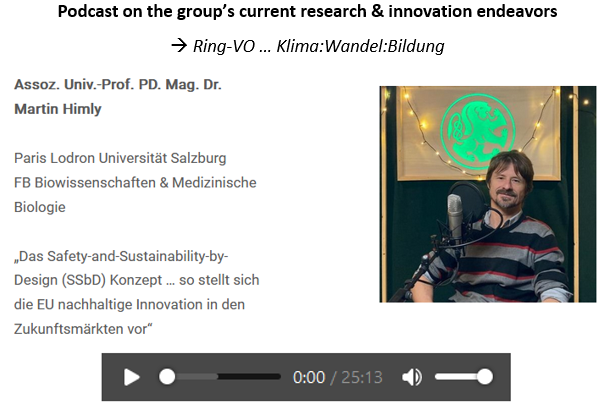
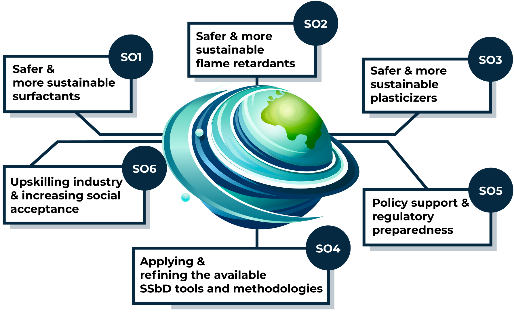
The Green Deal sets up ambitious roadmaps for increasing EU sovereignty while promoting safer and more sustainable approaches.The SSbD framework published by JRC and adopted by the Commission proposes an approach to evaluate the safety, environmental,and socio/economic dimensions of molecules, materials and processes. The applicability of this framework is currently being tested under different typologies of products and maturity levels. PLANETS, an innovation action funded by the EU under the HORIZON Resilience 01-24 call, will demonstrate the applicability of the framework while technically developing alternatives for 3 of the most importantclasses of molecules in chemical industries (plasticizers, flame retardants and surfactants) at TRL 6 and their incorporation into broadlyavailable consumer goods at TRL7. The new molecules and products will be significantly safer to workers and consumers and will have considerably lower environmentalimpact, while ensuring economic viability and social awareness throughout the 3 value chains. PLANETS‘ consortium brings together 18 complementary partners from 7 countries, including 7 large companies and 4 SMEs, covering the 3 complete value chains, 4 RTO and the 3 non-profit organizations.These actors bring the expertise required for all the project development:
– Development of safer and more sustainable alternatives through SSbD assessments in a tiered approach.
– Demonstration of the integration of the new molecules for the manufacturing of new products for various applications (coating,insulation foams and childcare articles).
– Social and humanities sciences.- Business plans and market uptake approaches.
– Digital Product Passport.- Identification of new skills and training.
– Interactions with appropriate stakeholders and citizens and feedback to JRC and the EC.
PLANETS‚ ambitions are to strongly contribute to pave the road for the adoption of SSbD framework while proposing a roadmaptowards industrialisation and market uptake of the alternative solutions.
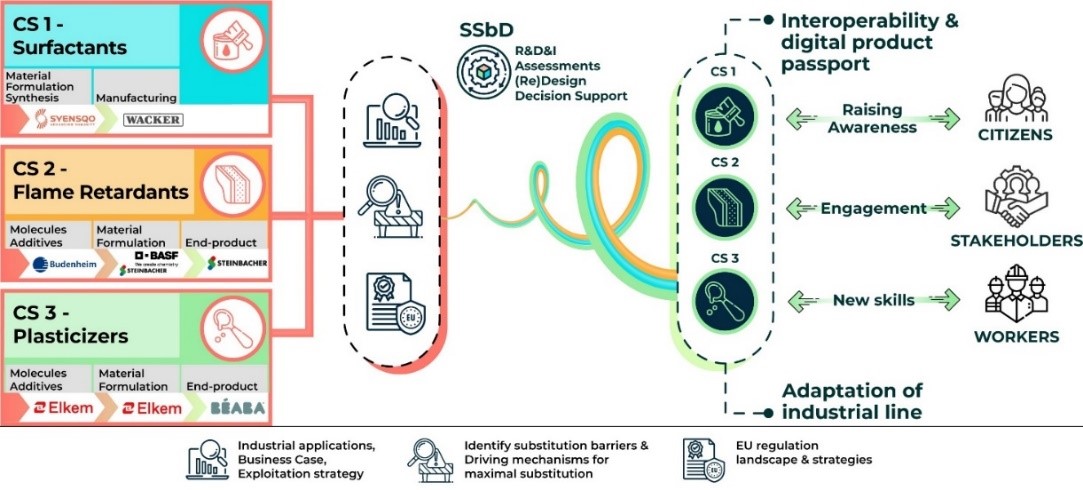
 The PINK project, a research and innovation action funded by the EU under the HORIZON Resilience 01-23 call, combines computational models and a decision support system (DSS) that exploit the combined power of first-principles simulation and pre-existing data, which – in itself – is further improved by advanced artificial intelligence (AI) technology; this provides PINK with the capability to significantly decrease the time needed for SSbD Advanced Materials & Chemicals development. However, this requires the integration of tools from different and (hitherto) partly independently developed areas. PINK provides this integration in the form of an open innovation platform, the PINK In Silico Hub (PINKISH) based on an advanced Interoperability Framework, giving access to all information and knowledge, and executing SSbD workflows customisable to (a) the application area of the Advanced Materials & Chemicals, (b) their safety and sustainability concerns of the existing materials, and (c) the status ofthe relevant development project (from early design ideas to registration and market entry).
The PINK project, a research and innovation action funded by the EU under the HORIZON Resilience 01-23 call, combines computational models and a decision support system (DSS) that exploit the combined power of first-principles simulation and pre-existing data, which – in itself – is further improved by advanced artificial intelligence (AI) technology; this provides PINK with the capability to significantly decrease the time needed for SSbD Advanced Materials & Chemicals development. However, this requires the integration of tools from different and (hitherto) partly independently developed areas. PINK provides this integration in the form of an open innovation platform, the PINK In Silico Hub (PINKISH) based on an advanced Interoperability Framework, giving access to all information and knowledge, and executing SSbD workflows customisable to (a) the application area of the Advanced Materials & Chemicals, (b) their safety and sustainability concerns of the existing materials, and (c) the status ofthe relevant development project (from early design ideas to registration and market entry).
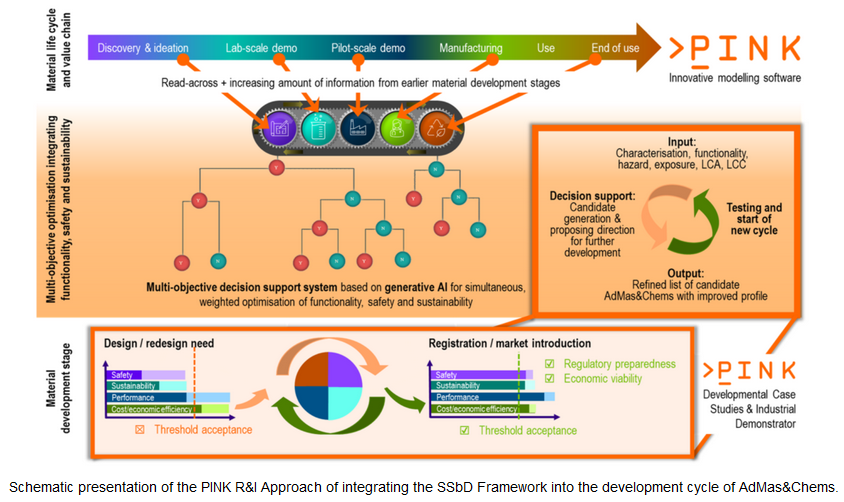
The unique properties of nanomaterials (NMs), relative to their bulk form, has seen them used in a rapidly increasing number of commercial applications. However, with these useful new properties of NMs come potential health and environmental hazards. Thus, as part of a responsible innovation approach, NMs potential risks must be assessed in parallel to exploitation of their benefits. Due to their enormous variability, NM risk assessment urgently needs advanced in silico methodologies capable of machine learning from limited experimental datasets. These in silico tools for NMs characterisation, exposure, hazard and risk assessment and sustainability and life cycle assessment, need to support implementation of existing regulatory guidelines and extend regulatory risk assessment to integrate the extensive new knowledge generated computationally. The EU H2020 MSCA RISE project CompSafeNano’s overarching objective is thus to drive the development of integrated and universally applicable nanoinformatics models, with broad domains of applicability across NMs compositions and forms, that are directly usable by industry, especially SMEs, and regulators for NMs risk assessment and decision making. CompSafeNano will establish an extended safe-by-design paradigm that includes environmental sustainability (life cycle assessment) based on in silico predictions with experimental testing to validate the results. CompSafeNano has a clear set of objectives to deliver this vision of an in silico safe-by-design computational platform and will be in close communication with other EU projects to access existing data on NM hazard and integrate existing nanoinformatics and NMs risk governance platforms. Training activities will benefit both ESRs and ERs from participating organizations, with a strong focus on inter-sectoral exchange (SME-academia) and international collaboration, filling the well-recognised current skills gap in nanoinformatics and big data analytics.
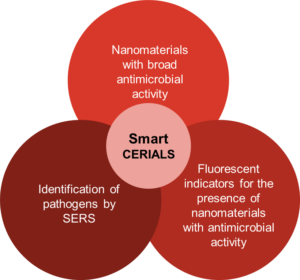 „SmartCERIALS – Smart CERIum dioxide-based nanocomposites for AntimicrobiaL Surface applications“ is a collaborative research project of the Bio-Nano Group at PLUS, the Phornano Holding GmbH, Korneuburg (4n), Austria, and the Shenzhen Institute of Advanced Technology (SIAT) of the Chinese Academy of Sciences (CAS) that AIMs at the green development of novel nanocomposite raw materials for smart surface coatings by additive synthesis of different nanomaterials allowing for the combination of different desired functionalities. These combined functionalities comprise (i) superior anti-microbial properties that can be (ii) monitored for microbial binding and deactivation and (iii) contain a long-term tracing feature for coating stability.
„SmartCERIALS – Smart CERIum dioxide-based nanocomposites for AntimicrobiaL Surface applications“ is a collaborative research project of the Bio-Nano Group at PLUS, the Phornano Holding GmbH, Korneuburg (4n), Austria, and the Shenzhen Institute of Advanced Technology (SIAT) of the Chinese Academy of Sciences (CAS) that AIMs at the green development of novel nanocomposite raw materials for smart surface coatings by additive synthesis of different nanomaterials allowing for the combination of different desired functionalities. These combined functionalities comprise (i) superior anti-microbial properties that can be (ii) monitored for microbial binding and deactivation and (iii) contain a long-term tracing feature for coating stability.
„NanoProCoV – Nanoformulations protecting against SARS-CoV-2 infection“ is a scientific & technological cooperation programme of the Bio-Nano Group at PLUS with the Shenzhen Institute of Advanced Technology (SIAT) of the Chinese Academy of Sciences (CAS), funded by the Austrian BMBWF and the Chinese MOST, for establishing cooperative research based on mobility of researchers and developing online training in nanomedicine with the aim to combat viral infection of the respiratory system.
- NanoProCoV – Nanoformulations protecting against SARS-CoV-2 infection
Nanotechnology-enabled products with enhanced functions and durability have entered the international markets. These products extend to skincare, electronics, textiles, sports equipment, and to applications in diagnostics and therapeutics. The rapid growth of nanotechnology economy has, upon significant funding by the European Commission, been accompanied by research in nanosafety assessment having resulted in the establishment of risk governance procedures and safe-by-design strategies. In the upcoming framework program termed Horizon Europe (2021-2027) this safety-related knowledge will be transferred to aid sustainable innovation, combat emerging contaminants of ecological concern, and tackle environmental challenges such as micro- and nanoplastics. Specific sources of emerging contaminants of ecological concern are nanomaterials-derived particulates, sanitizers and active pharmaceutical ingredients leaching into the environment. While the risk assessment of such substances in their individual state is rather straight forward and obligation of the producers, the one of mixture effects is much more complex and the resulting risk vs. revenue estimation basically remains with societal stakeholders including regulators or community authorities. The Austrian partner, the Bio-Nano Group at Paris Lodron University of Salzburg (PLUS) has built up a strong track record in nanosafety assessment focusing on human health, while the South African partner group at the University of Pretoria (UP) focuses on environmental aspects of emerging contaminants including nanomaterials. The “africa uninet” project PUSH will thus form a nucleation for future synergistic research and teaching for both partners.
-
The PLUS-UP European-African university network for Sustainable innovation and Health – PUSH
NanoCommons is a EU Research Infrastructure Activity to promote data FAIRness in nanosciences. The initiative, furthermore, serves the scientific community by means of consultancy and services providing e-tools for:
– design and implementation of experimental workflows
– data processing and analysis
– data visualization and predictive models
– data storage and metadata completeness
…to improve scientific quality assurance in the field of nanosafety assessment. NanoCommons offers as part of its Knowledge Infrastructure, a Knowledge Base and a Data Warehouse. The PLUS partner is responsible for education & training activities.
The EU NanoSafety Cluster Working Group A (WG-A) focuses on cross-linking all currently active projects in the EU NanoSafety Cluster. In addition, WG-A endeavors to align all training offers in nanosafety projects and beyond. This effort shall be including the research fields of microplastics’, advanced/innovative materials’, or nanomedicines’ safety assessment. Joint educational strategies are developed with representatives from the currently ongoing projects. The main activity to facilitate this essential and fruitful cross-talk between the people that are actively involved in the work of the projects is executed by informative webinars and virtual training sessions.
Nan-O-Style is an interdisciplinary research project, which investigates interactions between nanomaterials (NMs) in consumer products with substances from daily life with a special focus on modern lifestyle products (MLPs) used by adolescents.
Project overview
Principle Investigator
| 2025-2028 | SURPHACE – SUrface enhanced Raman spectroscopy for PatHogen sensing and Anti-pathogenic Coating devElopment, M.Era.Net, grant no. 12319 |
| 2025-2028 | NeuroNanotech: Nanoplatforms for Neuroscience, EU HORIZON MSCA-DN, grant no 101169352 |
| 2024-2028 | PLANETS – Plasticizers, fLame-retardants and surfactANts: new alternatives validating the safE and susTainable by deSign approach, EU HORIZON Resilience-01-24, grant no 101177608 |
| 2024-2027 | PINK – Provision of Integrated Computational Approaches for Addressing New Markets Goals for the Introduction of Safe-and-Sustainable-by-Design Chemicals and Materials, EC HORIZON Resilience-01-23, grant no 101137809 |
| 2024-2026 | CompSafeNano – NanoInformatics Approaches for Safe-by-Design of NanoMaterials, EU H2020, grant no 101008099 |
| 2024 | I-AM-Green- BMVIT, FFG, grant no FO999919961 |
| 2022-2025 | SmartCERIALS – Smart CERIum dioxide-based nanocomposites for AntimicrobiaL Surface applications, BMK, FFG, grant no 890610 |
| 2022-2024 | NanoProCoV – Nanoformulations protecting against SARS-CoV-2 infection, WTZ, BMBWF, OeAD, grant no CN 06/2021 |
| 2023 | TyreWear2Food – BMVIT, FFG, grant no FO999905045 |
| 2021-2024 | PUSH – The PLUS-UP European-African university network for Sustainable innovation and Health, BMBWF, OeAD, grant no P023_South Africa |
| 2020-2022 | Biological Standardization Programme – BSP163, Conseil de l’Europe & European Directorate for Quality of Medicine & Healthcare (EDQM) |
| 2019-2022 | NanoCommons – The European Nanotechnology Community Informatics Platform: Bridging data and disciplinary gaps for industry and regulators, EU H2020, grant no 731032, www.nanocommons.eu |
| 2019 | Nan-O-Style FeMED, BMVIT, FFG, grant no 874754 |
| 2018 | FeMINT physics and bioeffects, BMVIT, FFG, grant no 870755 |
| 2017-2019 | Nan-O-Style, Nanotechnology ↔ Modern Lifestyle, Sparkling Science, BMWFW, grant no P144200_25 |
| 2006-2013 | Development of bioanalytical tools for standardization of allergen products, Biomay, grant no BIO062004 |
| 2010-2012 | Bioanalysis of allergen extracts and allergoids, Diater, grant no P144250_9 |
| 2011-2012 | Bioanalysis of monomeric allergoids, Lofarma, grant no P144250_9 |
| 2006-2011 | Mechanism of drug-induced hypersensitivity against NSAIDs, FWF, grant no P18820-B13 |
| 2010 | Patterns of exposure and mechanisms of sensitization in allergic asthma caused by tropical mites, FFG, grant no 2108908, P144250_6 |
| 2010 | Managing Th1 and Th2 immune responses for cancer immunotherapy, Boehringer-Ingelheim Fonds, grant no P144250_10 |
| 2009-2010 | Comparative bioanalysis of allergen extracts, Lofarma, grant no P144250_9 |
| 2009 | Molecule-based diagnosis of allergy and related diseases caused by mites, FFG, grant no 823964, P144250_6 |
| 2007-2009 | Biological Standardization Programme – BSP090, Conseil de l’Europe & European Directorate for Quality of Medicine & Healthcare (EDQM) |
| 2006-2008 | Bioanalysis of allergen extracts and allergoids, Leti, grant no BIO062004 |
Project participation
| 2022-2023 | EndoNano – Qualitative detection of bacterial endotoxin by novel nanotechnological approaches, EU H2020 MSCA EID, grant no 812661 |
| 2019-2023 | NANORIGO “NANOtechnology RIsk GOvernance“. EU H2020, grant no 814530, www.nanorigo.eu |
| 2016-2021 | ICA – Immunity in Cancer and Allergy, International PhD Program, FWF, grant no W01213, www.ica.sbg.ac.at |
| 2016-2019 | PANDORA – Probing safety of nano-objects by defining immune responses of environmental organisms, EU H2020, grant no 671881, www.pandora-h2020.eu |
| 2016-2019 | EC4SafeNano – European Centre for Risk Management and Safe Innovation in Nanomaterials Nanotechnologies, EU H2020, grant no 723623, www.ec4safenano.eu |
| 2014-2017 | HUMUNITY – Cell-Based Models of Human Mucosal Immunity with Multiple Commercial Applications, EU FP7, grant no 316383, www.humunity.eu |
| 2013-2015 | ALRAUNE – Allergieforschung in ruralen, alpinen und urbanen Netzen, BMWFW, OeAD, Sparkling Science |
| 2012-2016 | Regulation of activation-induced deaminase by lysine modifications, FWF, grant no P24619 |
| 2012-2015 | NanoTOES – Nanotechnology Training of Experts in Safety, EU FP7, grant no 264506 |
| 2012-2015 | NanoValid – Developing reference methods for nanomaterials, EU FP7, grant no 263147 |
| 2012-2015 | NanoEIS – Nanotechnology Education for Industry and Society, EU FP7, grant no 319054 |




